![THE WRIGHT STUFF: Seventies Super Sirens The nineteen-seventies saw an unprecedented […]](https://web.archive.org/web/20151212051726im_/http://www.firstcomicsnews.com/wp-content/uploads/2015/09/The-Wright-Stuff.png)
 The nineteen-seventies saw an unprecedented rise in female superheroes. Women were demanding equal rights and equal representation and comic publishers were listening.
The nineteen-seventies saw an unprecedented rise in female superheroes. Women were demanding equal rights and equal representation and comic publishers were listening.
In 1972, the undisputed king of trends, Stan Lee suggested to Roy Thomas that they should put out some female-oriented comics. Stan came up with the ideas for each title and left it to Roy to find writers and artists for them. Rascally Roy decided to put female writers on each title.
 Night Nurse, while not a superhero, was part of the launch. It followed the adventures of a nurse named Linda Carter (no relation to Lynda Carter of Wonder Woman fame) and her two roommates. It was something of a soap opera in its feel, and only lasted four issues.
Night Nurse, while not a superhero, was part of the launch. It followed the adventures of a nurse named Linda Carter (no relation to Lynda Carter of Wonder Woman fame) and her two roommates. It was something of a soap opera in its feel, and only lasted four issues.
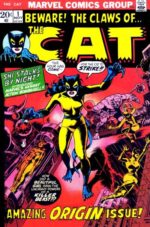 Claws of the Cat was an actual costume-wearing crimebuster named Greer Grant. Though the title only lasted three issues, Greer went on to become the striped seductress Tigra a mainstay of the Avengers, and her Cat costume was taken up by Patsy Walker who called herself “Hellcat” and became a regular in The Defenders.
Claws of the Cat was an actual costume-wearing crimebuster named Greer Grant. Though the title only lasted three issues, Greer went on to become the striped seductress Tigra a mainstay of the Avengers, and her Cat costume was taken up by Patsy Walker who called herself “Hellcat” and became a regular in The Defenders.
Shanna the She-Devil may have seemed like a jungle queen cut from the same cloth as Sheena, Jana, and Kara, she was an amazing character full of accomplishments and complicated plotlines. An Olympic athlete, zoologist, and fearsome fighter, she was no debutante lost in the jungles.
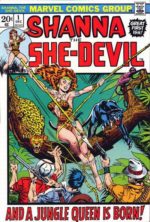 Though her book only lasted five issues, Shanna was too fierce to stay out of the limelight for long. She appeared in Ka-Zar and turned his head, she teamed up with Daredevil and Black Widow to defeat the Mandrill and Nekra, and eventually returned to the Savage Land and married Ka-Zar.
Though her book only lasted five issues, Shanna was too fierce to stay out of the limelight for long. She appeared in Ka-Zar and turned his head, she teamed up with Daredevil and Black Widow to defeat the Mandrill and Nekra, and eventually returned to the Savage Land and married Ka-Zar.
DC comics also decided in 1972 to give a female superhero her own title. While she had been the lead in Adventure Comics for forty-four issues, Supergirl finally had a book of her own with her name on the cover. Even though the book only lasted ten issues, Supergirl immediately became a regular in the Superman Family comic.
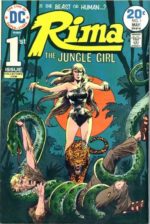 1974 saw DC comics give another heroine her own book. Rima the Jungle Girl was an adaptation of the novel “Green Mansions: A Romance of the Tropical Forest” by W. H. Hudson and played loosely with its likenesses. Seven issues saw the series come to an end, but not the end of Rima. In 1978 Rima joined the Superfriends in their cartoon for three seperate adventures,.and even appeared in The League of Extraordinary Gentlemen comic decades later.
1974 saw DC comics give another heroine her own book. Rima the Jungle Girl was an adaptation of the novel “Green Mansions: A Romance of the Tropical Forest” by W. H. Hudson and played loosely with its likenesses. Seven issues saw the series come to an end, but not the end of Rima. In 1978 Rima joined the Superfriends in their cartoon for three seperate adventures,.and even appeared in The League of Extraordinary Gentlemen comic decades later.
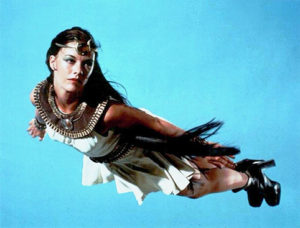 In 1975 television would see its first super-powered superheroine.in her own show. Isis (later renamed “The Secrets of Isis”) debuted on CBS’s saturday morning line-up. High school science teacher Andrea Thomas found a magical amulet that endowed her with the powers of the elements and animals. When she held her amulet to the sun and recited: “Oh mighty Isis!” she would be transformed into her superheroic form. Though her series only lasted two seasons, Isis remains in the hearts of those of us who grew up in that era.
In 1975 television would see its first super-powered superheroine.in her own show. Isis (later renamed “The Secrets of Isis”) debuted on CBS’s saturday morning line-up. High school science teacher Andrea Thomas found a magical amulet that endowed her with the powers of the elements and animals. When she held her amulet to the sun and recited: “Oh mighty Isis!” she would be transformed into her superheroic form. Though her series only lasted two seasons, Isis remains in the hearts of those of us who grew up in that era.
1976 was not only America’s bicentenial, but the year we saw not one, but four series with superheroines!
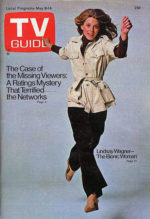 The Bionic Woman debuted on ABC on January 14th, 1976. A spin-off from The Six Million Dollar Man, this action adventure series was the first TV series in Prime Time to feature a superpowered woman as its lead. The Bionic Woman received worldwide acclaim and was the only science fiction TV series to ever reach a number one spot in the ratings in the UK in the twentieth century (quite an accomplishment considering Britain produced such venerable shows as Doctor Who, The Tomorrow People and Blake’s 7). Tennis Pro Jaime Sommers suffered a near fatal skydiving accident, but was fortunate enough to have the Six Million Dollar Man as her boyfriend and received bionic replacement parts. The show last three seasons, with the final season having switched to NBC.
The Bionic Woman debuted on ABC on January 14th, 1976. A spin-off from The Six Million Dollar Man, this action adventure series was the first TV series in Prime Time to feature a superpowered woman as its lead. The Bionic Woman received worldwide acclaim and was the only science fiction TV series to ever reach a number one spot in the ratings in the UK in the twentieth century (quite an accomplishment considering Britain produced such venerable shows as Doctor Who, The Tomorrow People and Blake’s 7). Tennis Pro Jaime Sommers suffered a near fatal skydiving accident, but was fortunate enough to have the Six Million Dollar Man as her boyfriend and received bionic replacement parts. The show last three seasons, with the final season having switched to NBC.
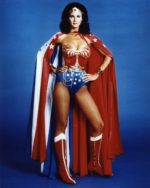 Wonder Woman made her star-spangled debut on April 21st, 1976 on ABC following a pilot TV movie that aired November of ’75 entitled “The New, Original Wonder Woman”. It should be note that another pilot TV movie featuring Cathy Lee Crosby as a very different (blonde) Wonder Woman in 1974, which is why the 1975 pilot movie contained “New, Original…” in its title. Fortunately for all Wonder Woman fans, the role was given to former Miss Universe title holder Lynda Carter who played the character with dignity and grace. While the show only lasted three seasons total, to this day, Lynda Carter remains the image of Wonder Woman for a good many people.
Wonder Woman made her star-spangled debut on April 21st, 1976 on ABC following a pilot TV movie that aired November of ’75 entitled “The New, Original Wonder Woman”. It should be note that another pilot TV movie featuring Cathy Lee Crosby as a very different (blonde) Wonder Woman in 1974, which is why the 1975 pilot movie contained “New, Original…” in its title. Fortunately for all Wonder Woman fans, the role was given to former Miss Universe title holder Lynda Carter who played the character with dignity and grace. While the show only lasted three seasons total, to this day, Lynda Carter remains the image of Wonder Woman for a good many people.
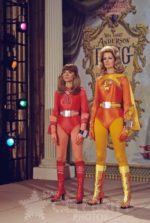 Electra Woman and Dyna Girl found their way onto Saturday morning TV as a segment of Sid and Marty Krofft’s live-action variety show called: “The Krofft Super Stars” in September of 1976. A tongue-in-cheek send-up of the Batman TV series, this dynamic duo of damsels were secretly Lori and Judy (no last names given) who were magazine reporters when they weren’t clad in their bright spandex costumes as Electra Woman and Dyna Girl. For some reason, they made no attempt at disguising themselves either as heroes or in their civilian identities. Armed with a wide array of high tech gadgets including their “ElectraComs” and the “ElectraCar” they faced such foes as: The Sorcerer, The Empress of Evil, Ali Baba, Glitter Rock, The Spider Lady, and The Pharoah and Cleopatra. Sadly, the “ElectraCouple” only saw one season on “Krofft Super Stars”.
Electra Woman and Dyna Girl found their way onto Saturday morning TV as a segment of Sid and Marty Krofft’s live-action variety show called: “The Krofft Super Stars” in September of 1976. A tongue-in-cheek send-up of the Batman TV series, this dynamic duo of damsels were secretly Lori and Judy (no last names given) who were magazine reporters when they weren’t clad in their bright spandex costumes as Electra Woman and Dyna Girl. For some reason, they made no attempt at disguising themselves either as heroes or in their civilian identities. Armed with a wide array of high tech gadgets including their “ElectraComs” and the “ElectraCar” they faced such foes as: The Sorcerer, The Empress of Evil, Ali Baba, Glitter Rock, The Spider Lady, and The Pharoah and Cleopatra. Sadly, the “ElectraCouple” only saw one season on “Krofft Super Stars”.
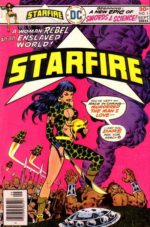 DC comics once again gave another superheroine her own title. This time she was an alien whose adventures took place on her home world. Starfire ( already the third DC character to bear this name) was a raven-haired, sword-wielding beauty who fought tyranny on her planet of Pytharia.
DC comics once again gave another superheroine her own title. This time she was an alien whose adventures took place on her home world. Starfire ( already the third DC character to bear this name) was a raven-haired, sword-wielding beauty who fought tyranny on her planet of Pytharia.
1977 saw the publication of two superheroine comics – Spider-Woman and Ms. Marvel, both by Marvel comics.
 Spider-Woman was Jessica Drew, a private detective who seemed be plagued by bad luck (much the way her namesake Spider-Man often was). Jessica’s first run ended after a respectable fifty issues with her death, though her popularity caused Marvel to bring her back from the afterlife. Probably owing to the fact that Spider-Woman was the longest running superheroine comic of the 1970s. Note: Spider-Woman also had a short-lived cartoon in 1979 that seemed to have been made in an effort to protect against what they perceived as a copyright infringement from a cartoon called Web Woman.
Spider-Woman was Jessica Drew, a private detective who seemed be plagued by bad luck (much the way her namesake Spider-Man often was). Jessica’s first run ended after a respectable fifty issues with her death, though her popularity caused Marvel to bring her back from the afterlife. Probably owing to the fact that Spider-Woman was the longest running superheroine comic of the 1970s. Note: Spider-Woman also had a short-lived cartoon in 1979 that seemed to have been made in an effort to protect against what they perceived as a copyright infringement from a cartoon called Web Woman.
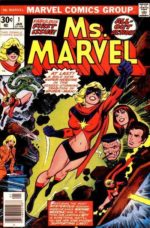 Ms. Marvel was the alter ego of Carol Danvers, a United State Air Force Officer who was in charge of security at a military base who became infused with some of the powers of Captain Marvel, the Kree superhero. Carol moved to New York where she she cajoled J. Jonah Jameson into becoming the editor of a new women’s magazine called: “Ms.”. At first, Carol was completely unaware that she was also Ms. Marvel, she would get blinding head aches and lay down, only to transform into her costumed self while unconcious. Eventually Carol became in control and her two aspects merged. This run ended after twenty-three issues even though twenty-five issues were already produced. The final two issues were published much later in 1990 in Marvel Superheroes #10 – #11.
Ms. Marvel was the alter ego of Carol Danvers, a United State Air Force Officer who was in charge of security at a military base who became infused with some of the powers of Captain Marvel, the Kree superhero. Carol moved to New York where she she cajoled J. Jonah Jameson into becoming the editor of a new women’s magazine called: “Ms.”. At first, Carol was completely unaware that she was also Ms. Marvel, she would get blinding head aches and lay down, only to transform into her costumed self while unconcious. Eventually Carol became in control and her two aspects merged. This run ended after twenty-three issues even though twenty-five issues were already produced. The final two issues were published much later in 1990 in Marvel Superheroes #10 – #11.
1978 saw the last three entries with Web Woman, Vixen, and Jana of the Jungle.
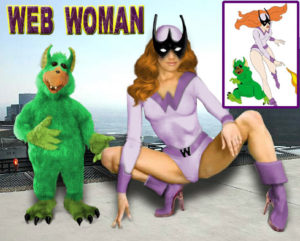 Web Woman was a cartoon segment of Filmation’s Tarzan and the Super Seven anthology series. Kelly Webster was an earth woman who saved the life of an insectiod alien who, thanked her by gifting her with a magical ring that embued her with the powers of the insect kingdom. She was given a secret headquarters, a spider-shaped vehicle, and comical green fuzzy companion by someone known as Scarab. Sadly, due to Marvel comics’ assertion that she was a copyright infringement and subsequent lawsuit, we will likely never see her adventures on DVD, though occassionally an adventure or two sometimes appears on YouTube.
Web Woman was a cartoon segment of Filmation’s Tarzan and the Super Seven anthology series. Kelly Webster was an earth woman who saved the life of an insectiod alien who, thanked her by gifting her with a magical ring that embued her with the powers of the insect kingdom. She was given a secret headquarters, a spider-shaped vehicle, and comical green fuzzy companion by someone known as Scarab. Sadly, due to Marvel comics’ assertion that she was a copyright infringement and subsequent lawsuit, we will likely never see her adventures on DVD, though occassionally an adventure or two sometimes appears on YouTube.
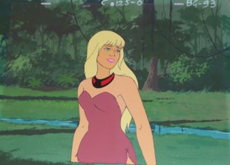 Jana of the Jungle debuted on Saturday mornings as a 30 minute cartoon series on The Godzilla Power Hour, then on The Godzilla Super 80. Jana was a typical jungle princess, basically a female Tarzan analog. She was assisted in her adventures by a handsome Wildlife Biologist, a stalwart jungle Native, and her animal companions Tico the coatimundi and Ghost the albino jaguar.
Jana of the Jungle debuted on Saturday mornings as a 30 minute cartoon series on The Godzilla Power Hour, then on The Godzilla Super 80. Jana was a typical jungle princess, basically a female Tarzan analog. She was assisted in her adventures by a handsome Wildlife Biologist, a stalwart jungle Native, and her animal companions Tico the coatimundi and Ghost the albino jaguar.
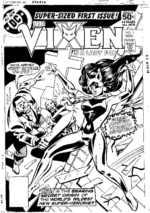 Finally, an honourable mention goes to DC comics’ Vixen. Vixen was set to be comics’ first black superheroine with her own series, but her comic was cancelled before it even began due to DC’s “Implosion” at the time. Vixen was Mari Macabe, a top fashion model who inherited a magical totem that granted her the powers of the animal kingdom. Vixen went on to become a regular in both the Justice League and the Suicide Squad. She has made appearances on the Justice League Unlimited cartoon, the Batman: The Brave and the Bold, and recently got her own animated web series that ties her to the “Arrowverse” of TV’s Arrow and The Flash.
Finally, an honourable mention goes to DC comics’ Vixen. Vixen was set to be comics’ first black superheroine with her own series, but her comic was cancelled before it even began due to DC’s “Implosion” at the time. Vixen was Mari Macabe, a top fashion model who inherited a magical totem that granted her the powers of the animal kingdom. Vixen went on to become a regular in both the Justice League and the Suicide Squad. She has made appearances on the Justice League Unlimited cartoon, the Batman: The Brave and the Bold, and recently got her own animated web series that ties her to the “Arrowverse” of TV’s Arrow and The Flash.
